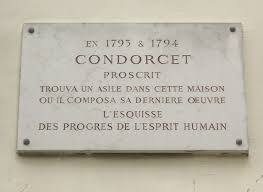|
Just as Olympe de Gouges did, Sophie de Grouchy had to relocate to the suburbs during the Terror. In 1793, the Jacobin Chabot had issued an order to arrest her husband, Condorcet. Condorcet had gone into hiding in the house of Madame Vernet, on the Rue des Fossoyeurs (now the Rue Servandoni). Their property was confiscated by the government, and Sophie, together with her young daughter, her nanny and her sister Charlotte, moved to a house on the Grande Rue D'Auteuil, not far from where Madame Helvetius lived. Several times a week, Sophie walked into Paris to visit her husband. As she did not want to be recognised, or to attract anybody's attention to Condorcet's hiding place, she came dressed as a peasant woman, pretending to be with the crowds of farmers come to sell their goods to the starving capital. Once through the gates, she would lose herself in the crowds come to see that day's executions at the Place de la Revolution (now Place de la Concorde), then cross the river to reach the left bank, and walked towards the church of St Sulpice, and beyond that to the street where her husband was hiding. Often she would bring him books, or notes that he needed for his work - as he'd had to leave home in a hurry. She would also stay and encourage him, and work with him. His last work, the Sketch of human progress, was almost certainly something they worked on together. After seeing her husband, Sophie would walk back across the Seine towards the Rue St Honoré, where she rented an underwear shop and the half-floor above it. Putting Auguste Cardot, younger brother of her husband's secretary, in charge of the shop, she set up a studio in the alcove and worked on her miniatures from there. Thus she insured that she had sufficient income to see to the needs of her husband, her family and herself until she could claim back some of what the government had seized.
2 Comments
Karen Green
4/18/2017 01:48:54 am
Lovely bit of research Sandrine. It would be great to see a map of Paris with all the various locations where the revolutionary women lived, worked, and sometimes died.
Reply
Anonymous
4/18/2017 02:25:42 am
I know! I tried to draw one (see the first post on this blog) but I'd love to find a proper big map of late 18thc Paris, like the ones they have on display in the Conciergerie (but of course, don't sell). Thanks for reading!
Reply
Leave a Reply. |
About
This is where I live blog about my new book project, an intellectual biography of three French Revolutionary women philosophers. Categories
All
Archives
November 2022
|




 RSS Feed
RSS Feed